Wigs have become an increasingly popular accessory for both men and women, offering a versatile and convenient way to change your look. However, one of the most important aspects of wearing a wig is finding the right glue to keep it securely in place. With so many different types of wig glues on the market, it can be overwhelming to know where to start.

In this comprehensive guide, we’ll break down the different types of wig glues, their pros and cons, and provide you with everything you need to know to choose the best one for your needs.
## Types of Wig Glues
There are four main types of wig glues:
- Water-based adhesives: These are the most common type of wig glue and are typically made from acrylic polymers. They are easy to apply and remove, and they come in a variety of strengths to accommodate different hair textures and wig weights.
- Solvent-based adhesives: These adhesives are stronger than water-based adhesives and are typically used for heavy wigs or wigs that are worn for extended periods of time. However, they can be more difficult to remove and may cause damage to the hair or skin if not used properly.
- Heat-activated adhesives: These adhesives are applied to the wig and then heated with a blow dryer or hair straightener to create a strong bond. They are ideal for wigs that are worn for special occasions or in windy conditions.
- Tape adhesives: These adhesives are applied to the wig and then attached to the scalp with double-sided tape. They are less visible than other types of adhesives, but they may not be as secure.
## How to Choose the Right Wig Glue
When choosing a wig glue, there are several factors to consider:
- Hair texture: If you have fine hair, you’ll need a glue that is strong enough to hold the wig in place without damaging your hair. If you have thick hair, you can use a weaker glue.
- Wig weight: Heavy wigs require a stronger glue to hold them in place.
- Wear time: If you’re only going to be wearing the wig for a short period of time, you can use a weaker glue. If you’re going to be wearing the wig for an extended period of time, you’ll need a stronger glue.
- Lifestyle: If you’re active or live in a windy climate, you’ll need a glue that is waterproof and windproof.
## Pros and Cons of Wig Glues
| Adhesive Type | Pros | Cons |
|---|---|---|
| Water-based | Easy to apply and remove, comes in a variety of strengths | Not as strong as solvent-based adhesives |
| Solvent-based | Stronger than water-based adhesives, can be used for heavy wigs | More difficult to remove, may cause damage to hair or skin |
| Heat-activated | Ideal for wigs worn for special occasions or in windy conditions, creates a strong bond | Can be difficult to apply and remove |
| Tape | Less visible than other types of adhesives, may not be as secure | Can be difficult to remove |
## Tips and Tricks for Applying Wig Glue
- Clean your scalp: Before applying the glue, make sure your scalp is clean and free of any oils or products. This will help the glue to adhere better.
- Apply a thin layer of glue: A thin layer of glue will be enough to hold the wig in place without causing any damage.
- Wait for the glue to dry: Allow the glue to dry completely before putting on the wig. This will help to ensure a strong bond.
- Use a blow dryer to set the glue: If you’re using a heat-activated glue, use a blow dryer to set the glue after it has dried. This will create a stronger bond.
- Remove the glue carefully: When it’s time to remove the wig, use a wig glue remover to loosen the bond. Do not pull or tear at the wig, as this can damage your hair or scalp.
## Frequently Asked Questions
- How long does wig glue last? The lifespan of wig glue varies depending on the type of glue used and how it is applied. Water-based adhesives typically last for 2-4 weeks, while solvent-based adhesives can last for up to 6 weeks.
- Can I use wig glue on my real hair? No, wig glue should not be used on real hair. It can cause damage to the hair and scalp.
- What is the best way to remove wig glue? The best way to remove wig glue is to use a wig glue remover. Do not pull or tear at the wig, as this can damage your hair or scalp.
## Conclusion
Choosing the right wig glue is essential for keeping your wig securely in place. By following the tips and advice in this guide, you can choose the best glue for your needs and achieve a natural-looking wig that will stay in place all day long.
